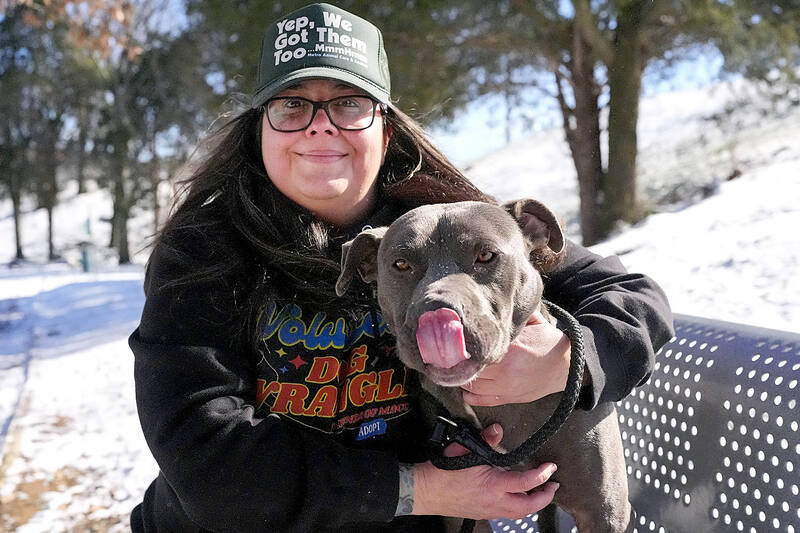For over a decade, Adrian Budnick has taken adoption photos of the dogs at Nashville’s county animal shelter, but it wasn’t until the COVID-19 pandemic that an idea came to her.
As one of only a few people allowed to visit in-person, she could take videos of dogs, inventing humorous nicknames and capturing their individual personalities, for an audience of potential adopters.
First came her TikToks playing the persona of Anita Walker, a fast-talking, cowboy boot-wearing purveyor of certified pre-owned pets. Then she struck gold with the “What’s this then?” series — short videos featuring goofy dog names that drew in viewers and boosted adoptions.

Photo: AP
VIRAL VIDEOS
“It was kind of just on a whim,” Budnick said. “We had this — I’m assuming it was like a poodle-doodle situation, and he was really big and lanky.”
People often assume the shelter doesn’t have fluffy dogs, so Budnick adopted what she calls her “Karen” voice — slightly bored and complaining — when she looked into the camera to say: “The shelter only has pit bulls.”

Photo: AP
“And then I held up this giant curly dog with legs and the tongue hanging out. And I was like, ‘What’s this then?’”
She called it a “Himalayan fur goblin.”
The video “exploded over night,” Budnick said. So much so that she went back the next day to make another one “because I’m like, I can’t let this go.”
Since then she has promoted the adoption of such imaginative dog breeds as the “Teacup werewolf” and the “Speckled freckled cuddle calf.” Then there’s the “French baguette long lady” and the “Creamsicle push-up pup.”
The shelter does get its share of pit bull mixes. A December video featuring several of them in festive costumes with Budnick singing “I Want a Pitt-o-potomous for Christmas” has been viewed more than 5 million times.
ADOPTIONS GET A BOOST
While it is gratifying to gain visibility, Budnick said, the real payoff is in the adoptions. Data provided by the shelter shows dog adoptions increased by just over 25 percent between 2021 and last year.
“We’ll get calls from all over. And it’s not just local here to Tennessee even,” said Metro Animal Care and Control Director Ashley Harrington. “We’ve had an adopter from Canada. We’ve had ones from states all over.”
She said people often call asking about a specific, made-up dog breed from one of the videos.
“It’s been pretty great, and it’s been fun for our staff.”
The popularity of Budnick’s videos have also led to donations of both money and supplies. Letters to the shelter referencing her videos are taped to a wall in the volunteer room.
Still, like many other shelters in the South, it’s overcrowded.
Budnick has one thing to say about that situation: “Spay and neuter, spay and neuter, spay and neuter.”
FOR THE LOVE OF DOGS
Budnick started taking photos as a kid. While on camping trips, she’d take nature pictures with a 35 mm Canon AE-1. In high school she took photography classes and learned to make her own prints in a darkroom. But eventually she stopped taking pictures.
That changed when she adopted a dog.
“When I got Ruby, my 13-year-old, she was five weeks old, and I started taking pictures of her,” she said.
A few months later, Budnick adopted Ruby’s sister, and a few months after that she began as a volunteer photographer at the shelter.
“So really, my dogs got me back into it.”
With her photos and videos, Budnick fights against the stigma that the shelter is a sad place with dogs no one would want. In many of the videos, she holds even the large dogs in her arms and gets her face licked.
“You see them running around in the videos when they’re in playgroup, and you see them cuddling, and you see their goofy smiles when I’m holding them, and it just really showcases them,” she said.
Budnick’s success has been noticed. She loves it when other shelters copy her ideas, or even lip sync over her videos while showing their own dogs, but she’s not interested in taking on more work. She has a regular job in addition to volunteering for the shelter between 7-10 hours each week, but she doesn’t mind the long hours.
“I’m just having fun,” she said. “I absolutely love dogs. I think they’re the best thing on earth.”

June 9 to June 15 A photo of two men riding trendy high-wheel Penny-Farthing bicycles past a Qing Dynasty gate aptly captures the essence of Taipei in 1897 — a newly colonized city on the cusp of great change. The Japanese began making significant modifications to the cityscape in 1899, tearing down Qing-era structures, widening boulevards and installing Western-style infrastructure and buildings. The photographer, Minosuke Imamura, only spent a year in Taiwan as a cartographer for the governor-general’s office, but he left behind a treasure trove of 130 images showing life at the onset of Japanese rule, spanning July 1897 to

One of the most important gripes that Taiwanese have about the Democratic Progressive Party (DPP) is that it has failed to deliver concretely on higher wages, housing prices and other bread-and-butter issues. The parallel complaint is that the DPP cares only about glamor issues, such as removing markers of Chinese Nationalist Party (KMT) colonialism by renaming them, or what the KMT codes as “de-Sinification.” Once again, as a critical election looms, the DPP is presenting evidence for that charge. The KMT was quick to jump on the recent proposal of the Ministry of the Interior (MOI) to rename roads that symbolize

On the evening of June 1, Control Yuan Secretary-General Lee Chun-yi (李俊俋) apologized and resigned in disgrace. His crime was instructing his driver to use a Control Yuan vehicle to transport his dog to a pet grooming salon. The Control Yuan is the government branch that investigates, audits and impeaches government officials for, among other things, misuse of government funds, so his misuse of a government vehicle was highly inappropriate. If this story were told to anyone living in the golden era of swaggering gangsters, flashy nouveau riche businessmen, and corrupt “black gold” politics of the 1980s and 1990s, they would have laughed.

In an interview posted online by United Daily News (UDN) on May 26, current Chinese Nationalist Party (KMT) Chairman Eric Chu (朱立倫) was asked about Taichung Mayor Lu Shiow-yen (盧秀燕) replacing him as party chair. Though not yet officially running, by the customs of Taiwan politics, Lu has been signalling she is both running for party chair and to be the party’s 2028 presidential candidate. She told an international media outlet that she was considering a run. She also gave a speech in Keelung on national priorities and foreign affairs. For details, see the May 23 edition of this column,